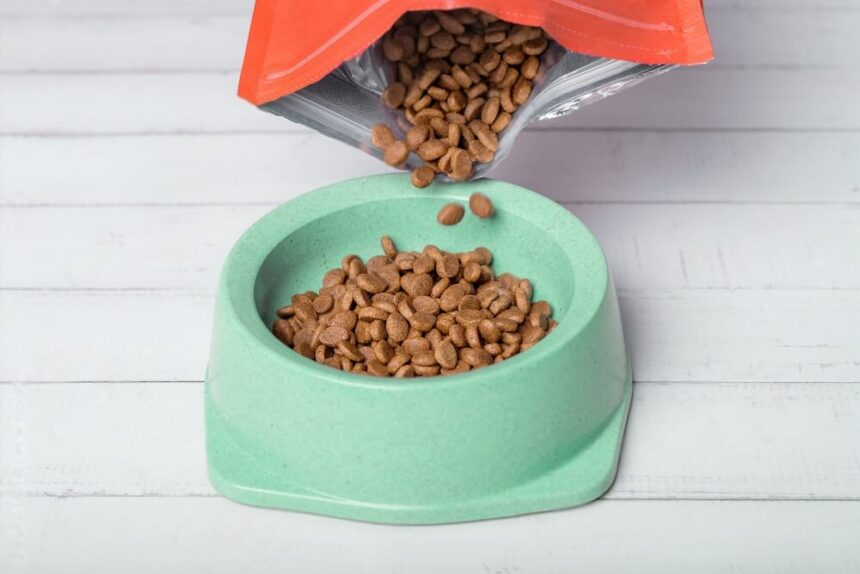Let’s be real—when it comes to our furry little overlords, we want the best. The best toys, the best cuddles, and of course, the best food. Dry cat food, or kibble, is a go-to for many cat parents because it’s convenient, affordable, and has a long shelf life. But here’s the million-dollar question: can dry cat food go bad?
Spoiler alert: yes, it can. And if you’re not careful, your cat might end up with a bowl of stale, rancid, or even moldy kibble. Yikes. Let’s dive into everything you need to know about keeping your cat’s food fresh, safe, and delicious.

Can Dry Cat Food Go Bad?
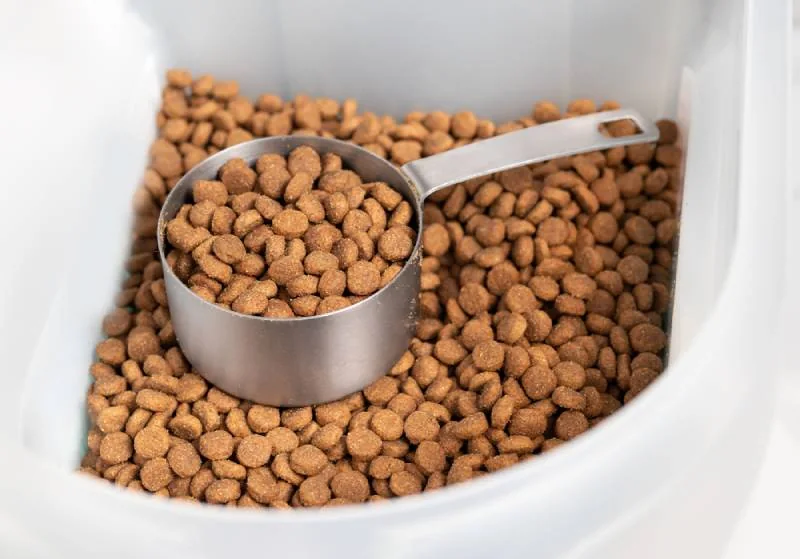
Yes, dry cat food can go bad. While it has a longer shelf life compared to wet cat food, it’s not immune to spoilage. Dry cat food can deteriorate or become unsafe for your cat to eat due to factors like exposure to moisture, air, and high temperatures.

Rachael Ray Nutrish Super Premium Dry Cat Food
Chicken with Lentils & Salmon Recipe, 14 Pounds (Packaging May Vary)

What Makes Dry Cat Food Go Bad?
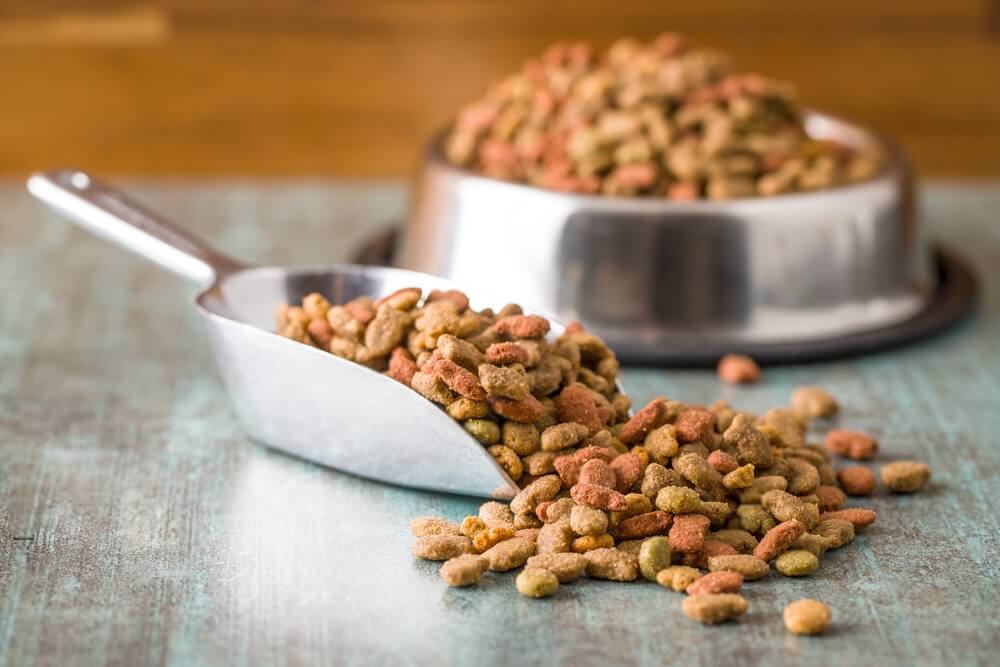
Dry cat food might seem like it lasts forever, but it’s not invincible. Several factors can cause it to go bad, and understanding these can help you keep your cat’s kibble fresh and safe. Let’s break it down:
Packaging Matters
The way dry cat food is packaged plays a huge role in keeping it fresh. Most manufacturers use specially designed bags with airtight seals to lock out moisture and air. But once you open that bag, the clock starts ticking.
- Resealable Bags: Look for packaging with a resealable closure. This helps maintain the food’s freshness after opening.
- Damaged Packaging: If the bag is torn or damaged, air and moisture can sneak in, speeding up spoilage.
Pro tip: If the original bag isn’t resealable, transfer the kibble to an airtight container.
Storage Conditions Are Key
Where and how you store dry cat food can make or break its shelf life.
- Cool and Dry: Store the food in a cool, dry place away from direct sunlight. Heat and humidity are kibble’s worst enemies.
- Avoid Extreme Temperatures: Don’t stash the bag in a hot garage or near a heater. High temperatures can cause the food to spoil faster.
- Keep It Sealed: Always seal the bag or container tightly after each use to keep out air and moisture.
The Expiration Date Isn’t Just a Suggestion
That “best before” or “expiration” date on the packaging isn’t there for decoration. It tells you how long the food is expected to stay fresh and nutritious.
- Freshness: After the expiration date, the food can lose its flavor, texture, and nutritional value.
- Safety: Old food is more likely to grow mold or bacteria, which can make your cat sick.
Always check the date before feeding your cat, and don’t take chances with expired food.
Quality of Ingredients Makes a Difference
Not all dry cat food is created equal. The quality of the ingredients can affect how long the food stays fresh.
- Premium Ingredients: High-quality proteins and natural preservatives tend to have a longer shelf life.
- Cheap Fillers: Low-quality ingredients can spoil faster and may not provide the nutrition your cat needs.
When shopping for dry cat food, choose reputable brands that prioritize quality.
Processing Methods Matter
How the food is made can also impact its shelf life.
- Extrusion: Many brands use a process called extrusion, which involves high heat and pressure to remove moisture. This helps reduce the risk of spoilage.
- Other Methods: Some brands use different techniques, so it’s worth researching how your cat’s food is made.
Understanding the processing methods can help you choose a product that stays fresh longer.
Fats and Oils Can Turn Rancid
Dry cat food often contains fats and oils to provide essential nutrients and make it more appealing to your cat. But these ingredients have a downside.
- Rancidity: Over time, fats and oils can turn rancid, giving the food a foul smell and taste.
- Moderation is Key: Look for products with a moderate fat content to minimize the risk of spoilage.

How to Tell If Dry Cat Food Is Bad
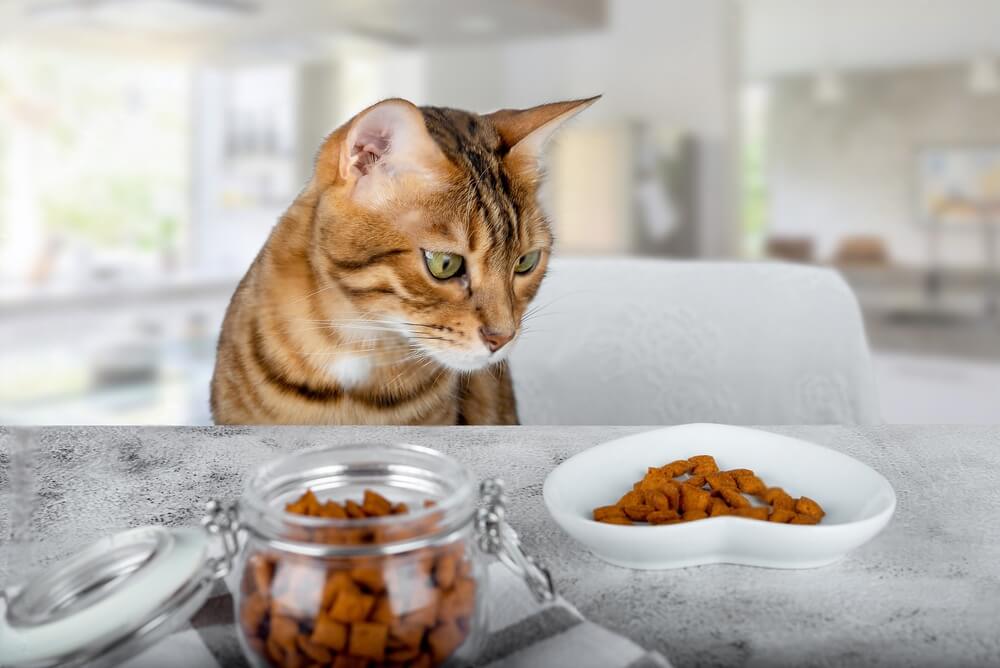
Cats are picky eaters, and for good reason. They can sense when something’s off with their food. Here’s how you can play detective and figure out if your cat’s kibble has gone bad:
Watch Your Cat: If your cat suddenly turns up their nose at their favorite food, something’s up. Trust their instincts.
Smell It: Fresh kibble has a mild, slightly meaty smell. If it smells sour, musty, or just plain funky, toss it.
Look at It: Mold, bugs, or discoloration are huge red flags. Also, if the kibble feels greasy or sticky, it’s probably rancid.
Check the Expiration Date: This one’s a no-brainer. If the date on the bag has passed, it’s time to say goodbye.

How Long Does Dry Cat Food Last?
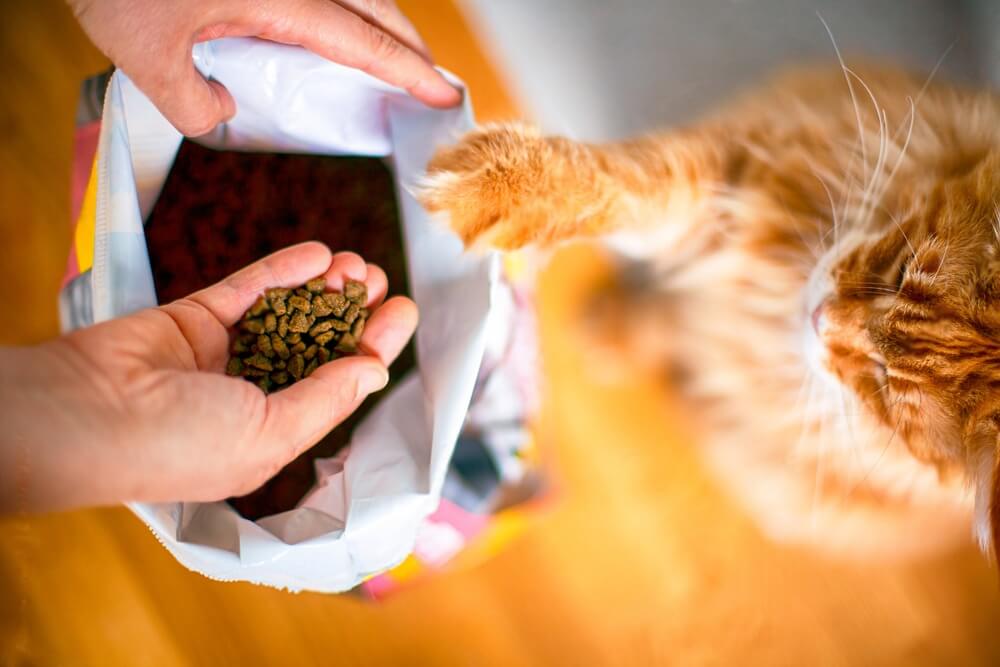
Dry cat food can last for quite a while if stored properly. When kept in a sealed container or its original packaging, dry cat food typically has a relatively long shelf life.
The exact duration depends on several factors, including the brand, specific product, and any preservatives used.
Unopened Dry Cat Food
When it comes to unopened dry cat food, you’re in luck. Most bags have a shelf life of 1 to 2 years from the date of manufacture. But here’s the catch: this timeline depends on the brand, ingredients, and preservatives used.
Storage Matters: Even unopened food can go bad if it’s stored in a hot, humid, or sunny spot. Keep it in a cool, dry place to preserve its quality.
Check the Date: Always look for the “best by” or expiration date on the packaging. This tells you exactly how long the food is expected to stay fresh.
Opened Dry Cat Food
Once you open that bag, the clock starts ticking. Exposure to air and moisture can significantly shorten the food’s shelf life.
Seal It Tight: To keep the food fresh, reseal the bag tightly after each use or transfer it to an airtight container.
4 to 6 Weeks: After opening, it’s best to use the food within this timeframe. Over time, the kibble can lose its freshness, flavor, and nutritional value.

How to Store Dry Cat Food the Right Way
Want to keep your cat’s kibble fresh and tasty? Follow these storage tips like your cat’s life depends on it (because, well, it kinda does):
Keep It Sealed: Once you open the bag, roll it tightly and clip it shut. Better yet, transfer the kibble to an airtight container. Those fancy pet food storage bins? Worth every penny.
Find the Perfect Spot: Store the food in a cool, dry place. Think pantry, closet, or cupboard—not the garage or basement.
Avoid Sunlight: UV rays can degrade the food’s nutrients and make it spoil faster. Keep it away from windows.
Don’t Mix Old and New: If you’re adding fresh kibble to an old batch, you’re just asking for trouble. Finish the old stuff first.
Wash the Bowl: Leftover crumbs can attract pests or bacteria. Clean your cat’s bowl regularly to keep things hygienic.

How to Keep Your Cat’s Kibble Fresh and Tasty
If dry cat food is not stored properly, it can lose its nutritional value, flavor, and even become unsafe for your cat to eat. Luckily, with a few simple tips, you can keep your cat’s kibble fresh and delicious for as long as possible.
Buy Smaller Quantities
One of the easiest ways to ensure freshness is to buy smaller bags of dry cat food. This is especially helpful if your cat doesn’t eat a lot or if you like to switch up their diet occasionally.
- Why It Works: Smaller quantities mean the food gets used up faster, reducing the risk of spoilage.
- Bonus Tip: Look for brands that offer resealable packaging to keep the food fresh after opening.
Choose Reputable Brands
Not all dry cat food is created equal. Some brands use better ingredients and packaging methods to extend shelf life.
- Quality Matters: Reputable companies often use high-quality ingredients and avoid harmful processing methods like extrusion, which can expose cats to allergens and toxins.
- Read Labels: Check the packaging for information about ingredients and manufacturing processes.
Store It Right
Proper storage is the key to keeping dry cat food fresh. Here’s how to do it:
- Airtight Containers: Transfer the kibble to an airtight container to lock out air and moisture. Containers like the IRIS USA Airtight Pet Food Storage Container are perfect for this.
- Cool and Dry: Store the food in a cool, dry place away from sunlight and humidity. A pantry or cupboard works great.
- Fridge or Freezer: For long-term storage, you can keep dry cat food in the refrigerator or freezer. Just make sure it’s in an airtight container to prevent moisture buildup.
Avoid Common Mistakes
Even small mistakes can lead to spoiled food. Here’s what to watch out for:
- Don’t Mix Old and New: Avoid mixing old kibble with a new batch. This can contaminate the fresh food.
- Keep It Separate: Don’t store rawhide treats or other pet products with dry cat food. This can increase the risk of spoilage and cross-contamination.
- Wash Your Hands: Always wash your hands before handling your cat’s food, especially if you’ve been handling raw meat, chicken, or fish.
Check for Spoilage
Even with the best storage practices, dry cat food can still go bad. Regularly check the food for signs of spoilage, such as:
- Foul Odors: Fresh kibble has a mild, slightly meaty smell. If it smells sour or rancid, toss it.
- Mold or Bugs: Visible mold or pests are a clear sign the food is no good.
- Texture Changes: If the kibble feels greasy, sticky, or looks discolored, it’s time to replace it.

IRIS USA Airtight Pet Food Storage Container
Up to 30 lbs, Attachable Wheels, for Dog Cat Bird and other Pet Food Storage Bin, Keep Fresh, Easy Mobility, BPA Free, Black

Does Dry Cat Food Go Bad If Left Out?

Leaving dry cat food out all day might seem convenient, but it’s not the best idea. Here’s why:
- Air Exposure: The longer the food sits out, the more it’s exposed to air, which can make it stale or rancid.
- Pests: Open bowls are like a buffet for ants, roaches, and other creepy crawlies.
- Moisture: Humidity can sneak into the bowl and ruin the kibble.

Blue Buffalo Healthy Living Natural Adult Dry Cat Food
Dry Food for Active Adult Cats, Chicken and Brown Rice Recipe, 7-lb. Bag

Does Dry Cat Food Go Bad After Opening?
Absolutely. Once you break that seal, the clock starts ticking. Air, moisture, and light can all sneak in and ruin the food. That’s why it’s crucial to store opened kibble properly.
Pro tip: If you buy big bags of kibble, consider splitting it into smaller portions and freezing some of it. Just make sure to thaw it completely before serving.

How Long Is Dry Cat Food Good for After Opened?
Once you open a bag of dry cat food, you’ve got about 4 to 6 weeks before it starts losing its freshness. To extend its life, store it in an airtight container and keep it in a cool, dry place.

Does Dry Cat Food Really Expire?
Absolutely. Dry cat food isn’t immortal. The expiration date on the bag isn’t just a suggestion—it’s a guideline for when the food is at its best. After that date, the food can lose its flavor, nutrients, and safety.

How Long Is Dry Cat Food Good After the Expiration Date?
Technically, dry cat food can last a little beyond its expiration date if it’s been stored properly. But it’s not worth the risk. Expired food can lose its nutritional value and even become unsafe. When in doubt, throw it out.

What to Do with Expired Dry Cat Food
Got a bag of expired kibble? Don’t just toss it in the trash. Here are some ideas:
- Compost It: If your kibble is mold-free, it can go in the compost bin.
- Donate It: Some animal shelters accept unopened, unexpired food. Call ahead to check.
- Trash It: If the food is spoiled, seal it in a bag and throw it away to avoid attracting pests.

Can Dry Cat Food Go Bad in Heat?
Heat is kibble’s worst enemy. Storing dry cat food in a hot garage, car, or near a sunny window can speed up spoilage and degrade its nutrients. Always store kibble in a cool, dry place.

Common Mistakes Cat Parents Make
We all want what’s best for our cats, but sometimes we mess up. Here are some common mistakes to avoid:
- Ignoring the Expiration Date: That date isn’t just a suggestion. Old food can make your cat sick.
- Using the Bag as Storage: Those flimsy bags aren’t airtight. Transfer the kibble to a proper container.
- Overbuying: Sure, that 20-pound bag is a great deal, but can your cat finish it before it goes bad?
- Skipping the Bowl Cleanup: Dirty bowls are a breeding ground for bacteria. Wash them daily.

What Happens If Your Cat Eats Bad Dry Food?
If your cat accidentally eats spoiled kibble, they might experience:
- Upset Stomach: Vomiting, diarrhea, or loss of appetite.
- Food Poisoning: In severe cases, mold or bacteria can make your cat seriously ill.
- Refusal to Eat: Cats are smart. If the food tastes or smells off, they’ll avoid it.
If you notice any unusual symptoms, call your vet ASAP. Better safe than sorry.

FAQs
Does Dry Cat Food Go Bad?
Yes, dry cat food can go bad if it is not stored properly or exceeds its expiration date. Due to its low moisture content, which aids in preventing the formation of bacteria and mold, dry cat food normally has a long shelf life.
However, the deterioration and spoilage of the food can be accelerated by exposure to heat, humidity, and air.
Can dry cat food go bad if it’s past the expiration date?
Dry cat food can lose its freshness and nutritional value if consumed after expiration. While it may not be harmful in most cases, it is best to adhere to the recommended guidelines for your cat’s well-being.
How can I make dry cat food last longer?
Store it properly in an airtight container, keep it in a cool, dry place, and don’t buy more than your cat can eat in a few weeks.
Can I freeze dry cat food to extend its shelf life?
Freezing dry cat food is not recommended as it can affect the texture and taste of the product. Additionally, moisture can develop when food is thawed, potentially leading to bacterial growth.
Is it okay to mix old and new kibble?
Not really. Mixing can contaminate the fresh food with whatever’s gone bad in the old batch.
Can I freeze dry cat food?
You can, but it’s not necessary. Just make sure to thaw it completely before serving.
Should I buy dry cat food in bulk to save money?
While buying in bulk may seem cost-effective, it is essential to consider the expiration dates and your cat’s consumption rate. Purchasing a large quantity that exceeds your cat’s needs may result in wastage and the risk of consuming expired food.
Are there any alternatives to dry cat food with a longer shelf life?
If you are concerned about the shelf life of dry cat food, you may consider alternatives such as freeze-dried or dehydrated cat food. These options often have extended shelf lives while still providing the necessary nutrients for your cat’s well-being.
Can Old Dry Cat Food Make Cats Sick?
Short answer: yes. Old or spoiled dry cat food can make your cat sick. Here’s what could happen:
- Upset Stomach: Vomiting, diarrhea, or loss of appetite are common signs of food-related issues.
- Food Poisoning: Mold or bacteria in spoiled food can cause serious illness.
- Nutritional Deficiencies: Old food loses its nutritional value, which can affect your cat’s health over time.
If your cat shows any unusual symptoms after eating old food, call your vet immediately.
Can Cats Get Sick from Dry Food?
Yes, but not because dry food is inherently bad. Cats can get sick from dry food if it’s spoiled, contaminated, or stored improperly. Always check the food before serving it to your cat.

Conclusion
So, can dry cat food go bad? Absolutely. But with a little care and attention, you can keep your cat’s kibble fresh, safe, and delicious. Remember, your cat relies on you to provide the best—so don’t cut corners when it comes to their food.
Store it right, check it often, and always trust your nose (and your cat’s nose) when something seems off. After all, a happy cat means a happy life.
Got more questions about dry cat food? Drop them in the comments below. Let’s keep our feline friends fed and fabulous!



